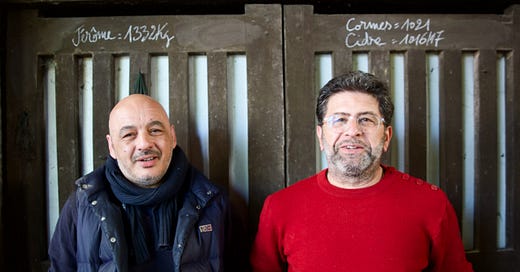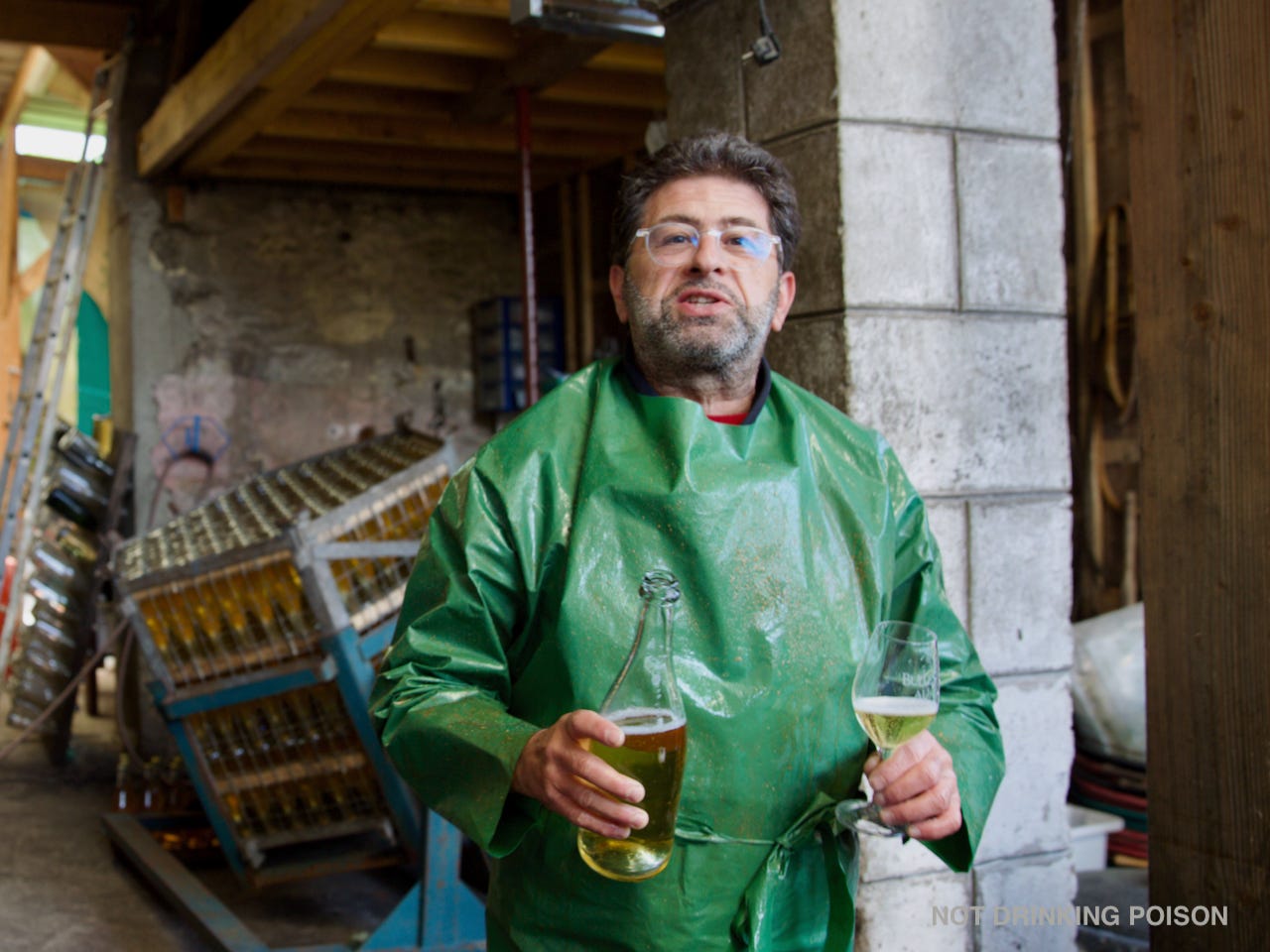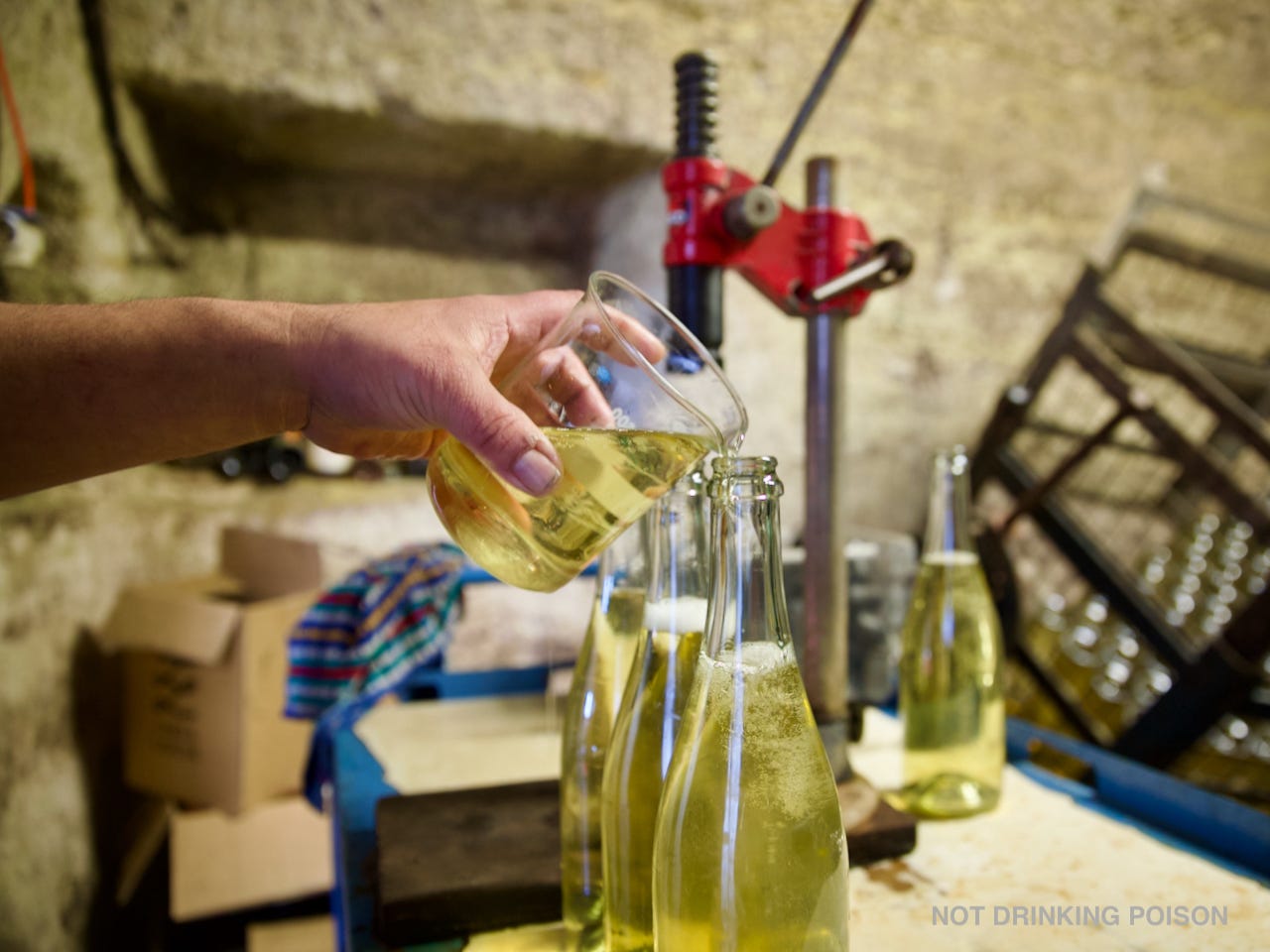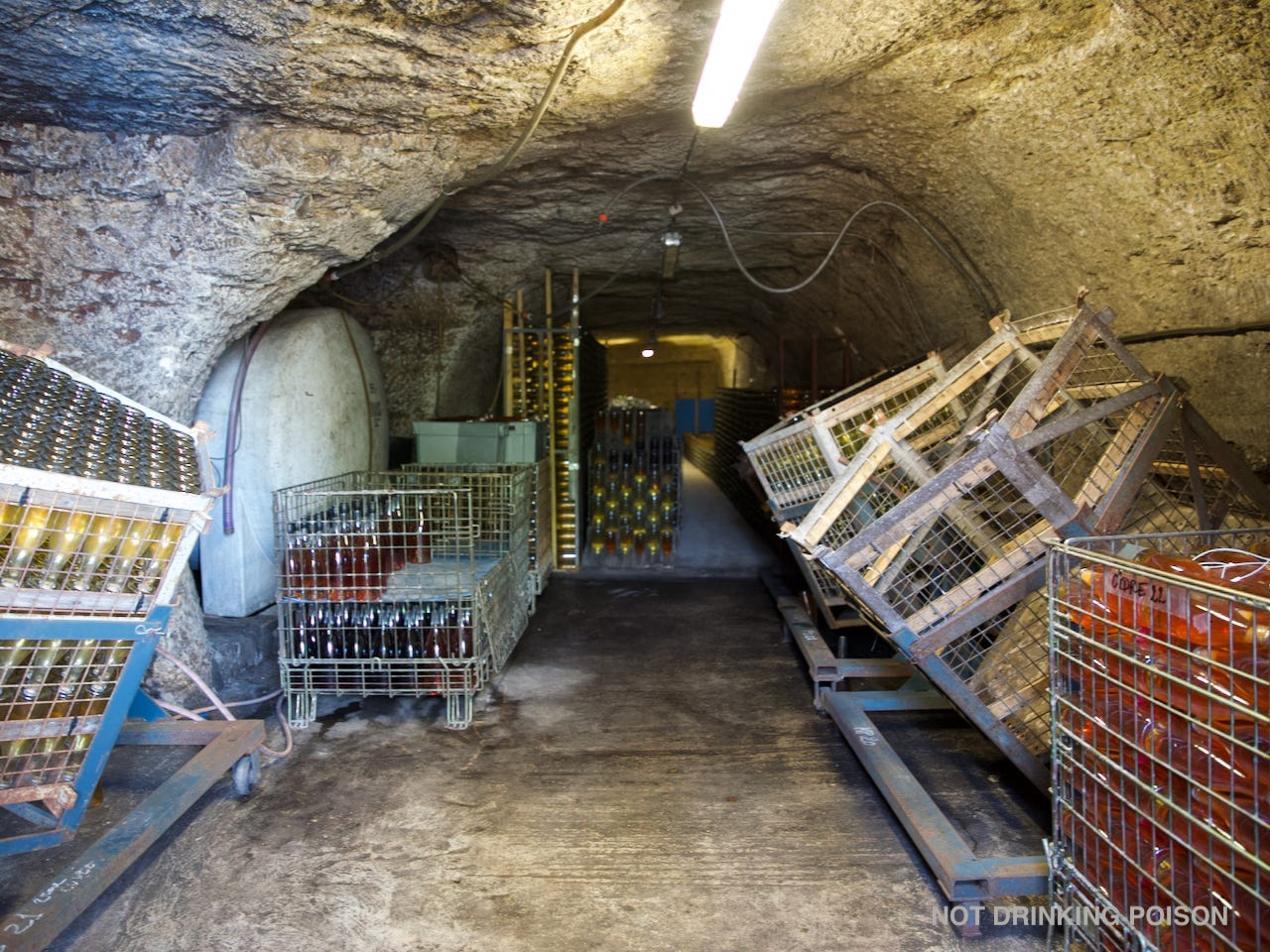The Legacy of Les Capriades
Pét-nat pioneer Pascal Potaire on the finer points of pétillant naturel production - and the end of Les Capriades, the winery he founded in 2005 and has run with partner Moses Gadouche since 2011.
Loir-et-Cher vigneron-négociant Pascal Potaire was among the handful of Loire winemakers1 responsible, in the late 1990s, for the resurrection of the pétillant-naturel within French natural wine circles (and its subsequent embrace worldwide). After establishing his own wine production as Les Capriades in 2005, he would become the sparkling wine style’s most vocal exponent, partnering with his friend Moses Gadouche in 2011 with the aim of demonstrating the complexity pét-nats can attain with longer bottle aging before disgorgement. In recent years, the duo have become France’s most prominent innovators in blending grape musts with those of other fruits, chiefly pear and apple, but also strawberry, rhubarb, and quince.2
I was in Sweden in April on the invitation of my wine importer friends Ulf Ringus and Emil Broomé of Vin & Natur, enjoying a magnum of Les Capriades’ 2018 “Pét Sec,” when Broomé informed me 2022 would be the estate’s final vintage. If the news came as as shock, it’s because estates rarely cease operations at the height of their influence, when the operators themselves are in good health and below retirement age.
I caught up with Potaire at his cellar in late May, as he and Gadouche disgorged a lot of 2022 “Pét Sec,” to learn more about the end of Le Capriades, what the future holds, and what he’s learned over two decades of finessing pét-nat production.
Quick Facts
Originally from Le Mans, Pascal Potaire began working in wine production in 1995 in Jasnières, working with Nicolas Renard until 1997, then at Clos Boudouin in Vouvray until 2001. From 2002 until 2004, he worked at Domaine Le Bois Lucas in the Loir-et-Cher.
Potaire began producing small lots of wines with Nicolas Renard in the mid-1990s. In 2003, he acquired his first parcels of chardonnay and menu pineau from local biodynamics pioneers Beatrice and Michel Augé, and established his own estate, Les Capriades, in 2005.
Initially Potaire produced both still wines and sparkling wines. His friend Moses Gadouche joined him as partner in the estate in 2011, at which point the duo began branching out into négociant purchases.
As of the 2013 vintage, Potaire and Gadouche began to concentrate exclusively on sparkling wine. They also adopted the use of Zorks, a resealable sparkling wine seal. All wines are disgorged by hand.
In 2012, Potaire and Gadouche founded Bulles au Centre, an annual sparkling wine fair held in Faverolles-sur-Cher. (The first public event was in 2014.)
In 2018, partly to make up for frost shortfalls in grape availability, Les Capriades began producing poiré and cider. These latter beverages (along with various blends with grape musts) would grow to represent 50% of the estate’s production by 2021.
In 2022, their final vintage, Potaire and Gadouche will have produced 35000 bottles. (Many will only be sold years from now.)
Grapes are pressed with a pneumatic press, after which musts undergo a day or a day and a half of débourbage, conducted using cooling plates. Fermenting musts are generally racked several times before bottling. Disgorgement of early-release wines generally begins in late spring.
Potaire and Gadouche are known for emphasizing long bottle-aging on lees, conducting disgorgement on a lot-by-lot basis. The striking clarity of their unfiltered, unsulfited pét-nats - and their impressive stability, even when released with residual sugar - is attributable to their racking regimen pre-bottling, combined with very precise hand disgorgement.
PASCAL POTAIRE: AN INTERVIEW
This interview was conducted on May 24th, 2023. It has been condensed and edited for clarity.
When did you first take an interest in pétillants naturels?
In 1995 or 1996, I met Christian Chaussard, who had already been making pét-nats in the 1990s. Hanging around with him allowed me to learn about it quite rapidly. In 1998, I was working at Clos Baudoin with Nicolas Renard, and we were already doing sketches of pét-nats back then.
After Christian, there was me and Nicolas Renard, Vincent Carême, and Emile Heredia. The first ones. At the time, I’d never heard anyone call their wines pét-nats elsewhere.
When I set up under my own name in 2005, I had already done a few since 2003. At some point, I wanted to make more cuvées, and to follow the cuvées each year, with different grapes, and different colors. So I needed to get more grapes. That’s why, in 2011, I proposed to partner with Moses [Gadouche] and really focus on sparkling wines.
Did you have to change your harvest dates quite a bit, when you decided to concentrate exclusively on pét-nats?
Lightly, but not enormously. It was an average of about one week before the others in the area.
For me, the principle of a pét-nat is to await sufficient maturity to have aromas, but without arriving at excessive alcohol or losing acidity. On average we harvest between 10.5-11% potential alcohol and 11.5-12%, depending on the year. For me that corresponds to wines that are aromatic and balanced, but which retain enough acidity to age.
I’ve heard many other vignerons throughout France often ask you for advice on producing pét-nats. What’s the most common question?
It’s usually about sugar density at bottling. It’s a beginner question. It maybe seems logical to think that we can always bottle at the same density. But for us, no. We’ve never had the same sugar density.
For me, the acidity is the line to follow. If there’s a lot of acidity, I want to have sugar to balance it, so I’ll bottle at a higher density. It depends on acidity and alcohol.
I’ve bottled at quite high densities: the highest I’ve bottled at was 1034, with a gamay teinturier. It’s enormous. There was a lot of acidity, and it was a question of lees, and temperature… It’s less about the amount of sugar, than the temperature of fermentation, and the management of lees in bottles. But it’s a little gymnastics to learn.
One thing to mention is that the people who came to us to ask about pét-nats were people who took pét-nats seriously, who wanted to make real wines. Whereas there are people out there who’ve been making pét-nats for ten or fifteen years and you feel like asking if maybe they should do something else…
How do you manage to bottle certain pét-nats with residual sugar without resorting to filtration or sulfite addition?
When I first thought about making a demi-sec pét-nat, I naively looked at the protocol of Clairette de Die. But it was lots of centrifuges and filtration… It didn’t correspond to the idea of pét-nat or what I want to do, so I started to experiment. I realized quite quickly that by saturating the milieu in CO2, we’d manage to make the lees descend, and to disgorge and block the sugars naturally.
So producing off-dry pét-nats depends partly upon a very well-managed disgorgement, which in turn depends upon high pressure?
With pét-nats, we don’t have the time to do an élevage on the lees; you have to bottle after a few weeks or one or two months at most. The work of élevage has to get done in the bottle. On the lees, in the spirit of the Champagne method. You need enough lees to nourish the milieu, but [that creates pressure and] with a strong pressure, there’s too much to be able to taste the wine [because without disgorgement it throws the lees into suspension upon opening].
That’s why for Christian [Chaussard], it was a long period of questioning, because his principle was to not disgorge pét-nats. But if you don’t want to disgorge them, you need to have very low CO2.
For me, the necessity of disgorgement came to me rapidly. Because [to taste the wine] we had to eliminate what we’d needed [to ferment it]. Now, if there isn’t enough CO2, you can’t expel the deposit [effectively]. So, since I wished to systematically disgorge, for me it was obvious you needed a minimum of gas to do it.
At the start, people bottled at 12g residual sugar, thinking, “Oh, I’ll have 3 bars of pressure, no problem.” I told them, “You’ll see, guys.”
To make a wine [that won’t continue fermenting after disgorgement], I bottle at 20g residual sugar - and not under 20g, because sometimes yeasts stop, and then you don’t have enough CO2. And when you disgorge to make a wine [that won’t continue fermenting], you have just one chance.
What about before bottling? Are there successive stages of racking, to wind up with less lees in the bottle?
That’s the principle: a few rackings.
We do a settling after direct press. On average, it lasts a night and a day. In terms of refrigeration, we have a milk tank connected to cooling sheets. It’s not super cold, but it allows you to settle the gross lees. We observe it all, and there’s a few rackings, to lessen the quantity of lees.
It’s also a way of putting the brakes on a fermentation of one variety, if you have another that you’re going to blend it with coming in. Notably our rosé, which is three varieties.
In recent years, it’s been interesting to see generational and regional schisms develop within the category of pét-nat. Many younger estates - and many from the New World and Central Europe in particular - aren’t disgorging pét-nats. Some include text on wine labels to encourage drinkers to put lees in suspension before serving.
It’s quite frustrating, because we really fought against that. Such wines reinforce this idea that pét-nats are like primeur cuvées. For me, the taste corresponds to the end of fermentation in barrel, a cuvée that hasn’t settled yet, that has a few grams of sugar. It’s agreeable, and why not?
But people making these are a generation behind…. Even Christian [Chaussard] ended up disgorging his pét-nats. When you’ve aged the wine for months or years, it’s indispensable to disgorge.
Many years ago, a vigneron asked me, “Why do you disgorge your pét-nat”?
The explanation that I found was: when I visit someone to taste from barrel, I’ve never seen a vigneron dip into the lees with the pipette, or do a battonage before having me taste a wine.
We always have people taste clear wine. That’s the reality. What is disgorgement? It’s simply a racking. Before bottling a cuvée that you’ve had in barrel for one or two years, you rack. So it’s shocking to see that, even within natural wine, there are opposing camps about this. But it’s human nature.
It’s also probably because disgorgement is a huge hassle.
Vignerons who take an interest in pét-nats often complain that disgorgement takes 90% of the time. It’s enormous! But we get nothing from doing nothing. The [alternative is the] caricature where we bottle a cloudy wine and we sell it.
But also I think it’s the fault of a lot of vignerons in Europe, who let the Champagne method take the place of the age-worthy cru [within the wine market]. People think pét-nats are quickly made, to drink quickly, without asking questions, and the Champagne method is made for doing things well. That’s what tends to annoy me. Why not make pét-nats well?
We wanted to do things differently, to show the terroir, with years of aging. That’s also thanks to Moses, because he accepted the risk. It was really the goal of the partnership of Les Capriades, to demonstrate that. It was to show that pét-nat can age, that it’s a real wine. If no one does it, you can’t prove it.
Was there any specific reason you and Moses decided to stop working together as Les Capriades?
There were quite a few reasons. We were planning to change importers in [REDACTED NATION] this year, because it had been complicated for years and years with our importer there. And then we changed our mind, we thought maybe it was a good time to give it up. We’d already spent a lot of time together, and life evolves. We aren’t the same age as when we began. It’s a whole ensemble of reasons.
But you have to call things what they are: it’s a divorce, but an amicable one.
We’ll to continue to distribute the wines in the best possible way, as slow as possible, to valorize the cuvées. We have 2022s - the chenin, the menu pineau - that we were planning to age on lees for three, four, or five years. So the wines will be on the market for a while.
What are your plans for after Les Capriades?
I have two little parcels of white grapes. I’ll have to harvest them. I’d prefer to continue to make wine, but not at this scale. I think the name Les Capriades will disappear, because even if I had the estate before, it became finalized with Moses. I’ll use my own name, that way there won’t be confusion.
I’ll continue to make bubbles, but it’ll be possibly a few thousand bottles. It’ll be white, because I have chardonnay and menu pineau. But there will be systematically some pears that will get transformed. If I lack any grapes, it’ll be pears.
Anyway, if you deprived me of my metier immediately, I’d die. I feel like continuing, because I’m not ready to stop. I still have lots of ideas.
There’s still a lot of work to be done.
In France, in terms of the media, there was never any infatuation. We’ve never had an in-depth article in French. They’ve all been elsewhere. I think in France people are a bit blasé about wine production. It’s basically that.
It was still a little revolution, the pét-nats. But twenty-five years is nothing in terms of the history of wine in a country like France. It’s not a lot of time. I still thought it would go a little faster. Today there are people who make age-worthy pét-nats. But not many.
FIN
Les Capriades - Pascal Potaire & Moses Gadouche
6 Rte de Tours
41400 FAVEROLLES-SUR-CHER
FURTHER READING
A fantastic, in-depth 2021 report on Les Capriades’ poiré at Wine Terroirs.
A splendid 2015 report on Les Capriades at Wine Terroirs.
An excellent 2019 report on Les Capriades’ poiré by their neighbor Emily Dilling at Sprudge.
Jon Bonné, writing for Punch in 2017, concludes an otherwise astute analysis of the state of the pét-nat market - and Les Capriades’ wines - by lauding the Montlouis appellation’s wrongheaded “pétillant originel” category, which, incidentally, Potaire himself considers a total joke. (As it is written, it permits a maximum of 2.5 bars of pressure, a weirdly defined window which is almost impossible to hit with any regularity when producing a pétillant naturel.)
Most cite the late Vouvray vigneron Christian Chaussard as the first to begin experimenting with pétillant-naturels in the modern era, followed soon after by Nicolas Renard, Emile Heredia, Pascal Potaire, and Vincent Carême.
In recent years these have become known colloquially in the USA as “co-ferments,” but the terms is imprecise, since it implies that the diverse fruits involved in their creation literally ferment together in the same recipient, while in reality a significant amount of such beverages are created by blending musts that fermented separately, or mostly separately.







